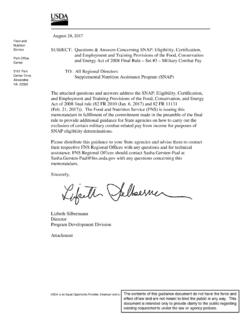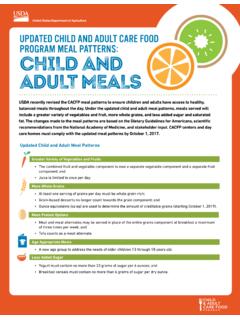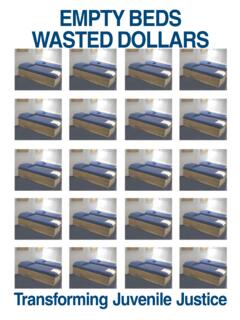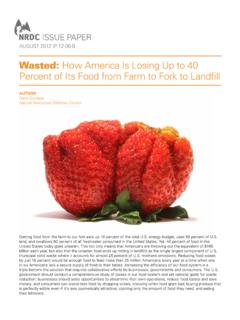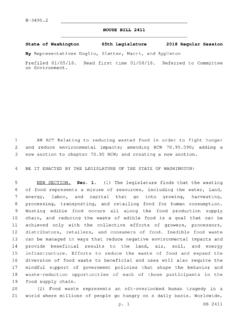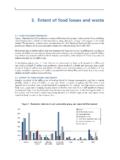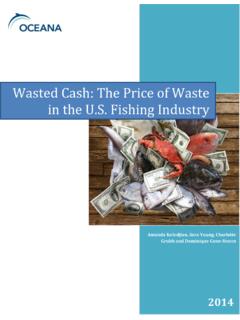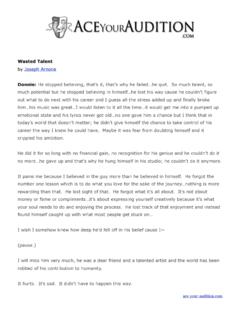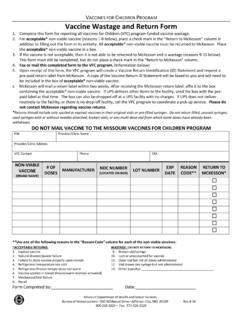Transcription of What You Can Do to Help Prevent Wasted Food
1 What You Can Do ToHelp Prevent Wasted FoodIn the United States, food loss and waste is about 30 percent of the food supply at retail and consumer levels. While the amount of food Wasted at schools has not increased during recent years, there are many ways that everyone on a school campus can help reduce, recover, and recycle food before it goes to : TIPS FOR SCHOOL STAFF, PARENTS, AND Tips for School Nutrition Professionals1 Buy what you need. Use production records and our food Buying Guide ( )to help you reduce leftover food sharing.
2 Partner with your local health department to implement safe practices that encourage kids to leave unwanted food on share tables. Market your new foods on your menus and serving lines. Consider holding taste testsand recipe competitions or creating a student advisory committee to provide feedback on food acceptability and recipe names. Check out the Team Nutrition Popular Events Booklet for resources: food acceptability. How do students feel about the foods being served? Is the fresh fruit ripe? Is the milk cold? Find out through student surveys or by doing your own check of what is kids a choice.
3 Participate in the Offer Versus Serve option, which allows students to decline some of the food offered in a reimbursable lunch or breakfast. Or, consider a salad or produce bar to give children more choices among a variety of fruits and fruit into smaller pieces. Whole fruit is more likely to be thrown away. Orange slices and apple quarters are easier and faster for kids to a Smarter Lunchroom. Offer a grab-and-go line for kids who want to get through the line faster so they have more time to eat. Use serving utensils that help kids take reasonable portions.
4 Get more ideas at: Tips for Teachers3Do a class food waste with your class and ways to reduce it. Consider a composting project. Check out these resources from the Environmental Protection about safe excess foods from the cafeteria for food science and cooking activities in the classroom. Encourage healthful school gardens and nutrition education activities into Science, Technology, Engineering, and Mathematics (STEM) classroom lessons. Get free class materials fromTeam Nutrition at: local food a trip to a farm, garden, or farmers market and learn about gleaning, the act of collecting excess fresh foods in order to provide it to those in need.
5 Find more informationat: them with praise, not of using sweets and food parties as incentives for good behavior or grades, try non- food rewards instead. Students may not have an appetite for healthful meals if they fill up on sweets and snacks beforehand. Tips for Administrators4 Schedule recess before can reduce plate waste by as much as 30 kids time to the lunch period from 20 to 30 minutes can help reduce waste by nearly safe with your health department and local hunger relief organizations to donatesafe and wholesome food .
6 See the USDA memo on food donation the food Waste Challenge!Sign up today so your school is recognized. More information is for ParentsHave a try day at home. If your school offers a food your child has not eaten before, consider making it and trying it at home toget her. Take action at school. If you are able, volunteer at your child s school cafeteria and help younger children open milk cartons, yogurt, and other food packages. Make room for healthful meals. Encourage your school s parent organization to choose fundraisers that do not involve the sale of food during the school day.
7 Work with teachers to schedule celebrations involving food later in the day. This way, kids will not be too full to eat healthful meals at lunch and breakfast. Get more information about healthier school fundraisers at: food waste at home. Wondering what to make with leftover ingredients? Find kid-approved recipes at: need foods from all of the five MyPlate food groups to learn, grow, play, and stay healthy. But, it can be discouraging when children do not eat the healthful foods offered to them. Keep these tips in mind for foods offered at home or at school.
8 Encourage sensible portions. Teach kids to take smaller amounts and then go back for seconds if they are still hungry. Don t ask children to eat everything on their plate. This can teach kids to overeat even when their body feels full. New foods take time. Sometimes children do not take to new foods right away. If children reject a food , try preparing it a different way instead of removing it from the menu altogether. Nutrition education and promotion can also help encourage children to try new foods. 5 RaisingHealthy for StudentsSign up, join in.
9 Be part of surveys, taste tests, and advisory groups that help your cafeteria decide what goes on the school it with you. If your school offers whole fruit and you don t have time to eat it, take it with you if your school allows it. Enjoy the fruit later as a around. If food is being Wasted at your school, home, or in your community, work with teachers and a student club or student leadership group to come up with ways to reduce, reuse, or recycle Department of Agriculture food and Nutrition ServiceUSDA is an equal opportunity provider and | July 2016

